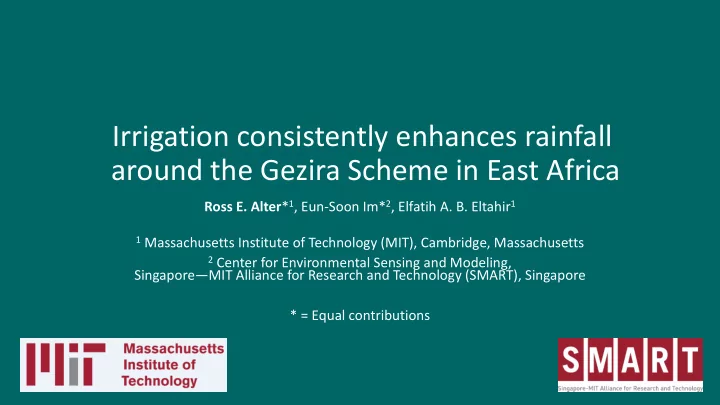

Irrigation consistently enhances rainfall around the Gezira Scheme in East Africa Ross E. Alter * 1 , Eun-Soon Im* 2 , Elfatih A. B. Eltahir 1 1 Massachusetts Institute of Technology (MIT), Cambridge, Massachusetts 2 Center for Environmental Sensing and Modeling, Singapore—MIT Alliance for Research and Technology (SMART), Singapore * = Equal contributions
Background • Rapid changes in land use and land cover (LULC) over the course of the 20 th century • Global area equipped for irrigation (Siebert et al., 2015) • 1900 = 63 million ha • 1950 = 111 million ha • 2005 = 306 million ha • Irrig water withdrawal • 2217-3185 km 3 yr -1 (Siebert et al., 2015) Source: FAO, 2013
Irrigation Studies • Previous research has shown that irrigation may affect: • Soil moisture • Surface energy budget • Air temperature • Atmospheric moisture ? • Wind patterns • Rainfall • The effects of irrigation on rainfall Source: Boucher et al., 2004 [adapted] are most difficult to determine
Harding and Snyder, DeAngelis et al., 2010 2012 U.S. Midwest July precip anomalies (%) May-Sept mean irrigation-induced precip (mm)
mm d -1 West Africa Im et al., 2014 • “Hot spot” for soil moisture-rainfall coupling (Koster et al. 2004) • Simulations with hypothetical irrigated areas • Opposing effects on rainfall Im and Eltahir, 2014
Motivation for work in East Africa • West Africa studies are only hypothetical • No large-scale irrigation schemes in West Africa for validation • We need observations to substantiate theoretical results Adapted from FAO, 2013
Experimental Design • Simulations using the MIT regional climate model – MRCM • Three 30-year simulations from 1979 to 2008 (90 total years) • 20-km horizontal grid increments • Irrigated grid cells are wetted to relative field capacity from July to September Alter et al., 2015
Observational Analysis • Manaqil Extension (MEX) • Rapid expansion from 1958- 1962 (blue vertical bar) • Obs time periods used • Pre-MEX– 1930-59 • Post-MEX – 1970-99 • Data sources • Gridded data (University of Delaware - UDel) • Station data (GHCN) Alter et al., 2015 (data from Ministry of Water Resources and Electricity in Sudan)
Alter et al., 2015
July August (a) (b) Dots Where irrig rainfall > Simulated control rainfall in at least 70% of model years (c) (d) (d) (c) Dots Observed ≥80 th percentile of (UDel) Consistency of Relative Change Index (CRCI) Alter et al., 2015
Wad Medani Gedaref GHCN Alter et al., 2015
Surface air temperature (K) Rainfall Potential Mechanism Wind @ 925 hPa (m s -1 ) Omega @ 700 hPa (Pa s -1 ) Rainfall Source: Im et al. 2014 Alter et al., 2015
Implications and Future Work • Negatives • Possible feedback loop that challenges hydrological sustainability • Positives • Can improve productivity of existing crops (e.g., Gedaref) or create new areas of cropland • Optimize locations of irrigated cropland • Currently applying same experimental framework for irrigation in central United States
Conclusions • Simulations and observations agree that irrigation in Gezira: • Enhances rainfall around irrigated areas • Reduces rainfall over irrigated areas • Cools temperature over irrigated areas • Enhancements in rainfall are consistent • Negative effects over irrigated area, positive effects in surrounding areas • Strategic placement of irrigated cropland can be beneficial for economies in Africa and the rest of the world
Thank you! Source: Visible Earth, NASA
Recommend
More recommend